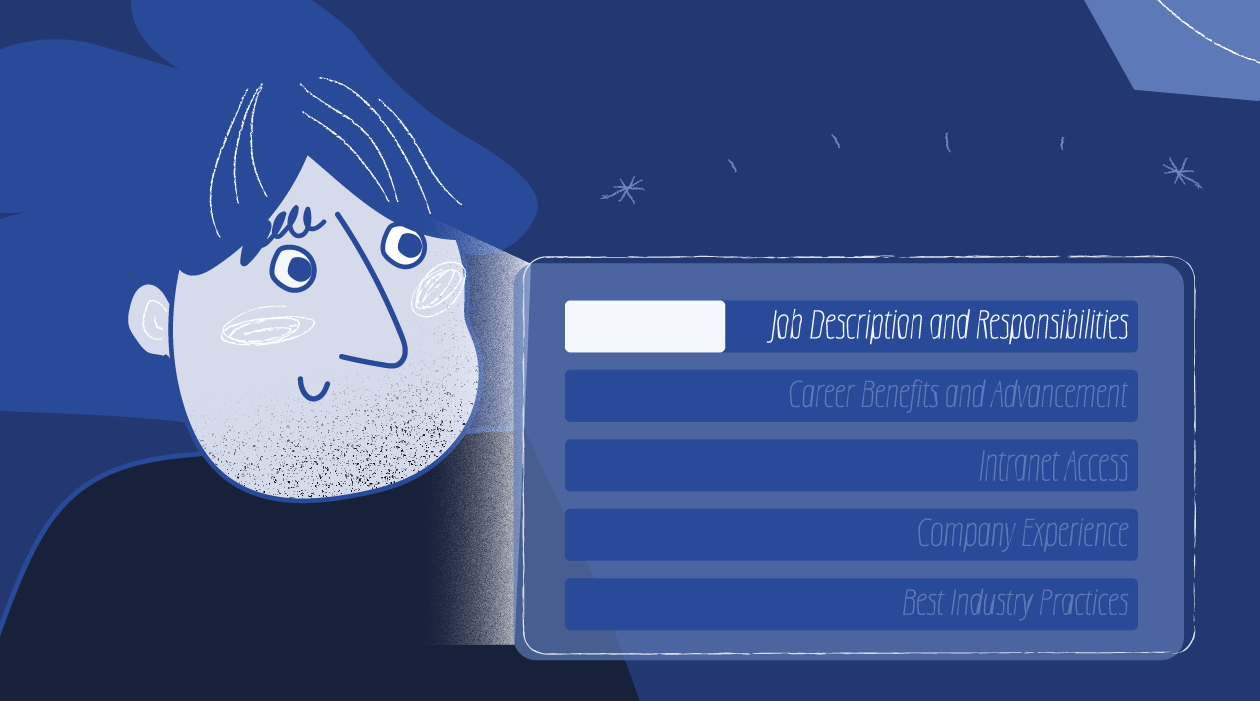Employee onboarding, organizational socialization … it goes by different names. But we can agree that giving new employees the knowledge and skills they require to navigate your organization makes them more effective workers. And there are a number of ways to deliver this information. You can use video onboarding to automate the orientation and basic training processes, and you can also use voice-over for employee training videos.
However, onboarding can be a repetitive, and thus tiresome process particularly because it addresses the same concerns.
How to do the job, where to go for information, who to ask questions – the list goes on.
Employee onboarding can improve workflow and increase motivation, but it also requires significant financial and human resources.
The good news is that you can automate the employee onboarding process in your organization with online courses. You will use fewer resources to bring the new recruits up to speed, and you might also get better results.
We crafted a full guide on how to automate the onboarding process with online courses, without compromising on results.
Define your Onboarding Goals
What does onboarding mean to your organization? What information do your new hires need to know before they start?
It costs a lot to hire new workers, which is why you should strive to get it right from the start.
Apart from improving employee retention, onboarding gives new hires a lot of confidence in your organization. Well-onboarded employees are more likely to commit to the company’s long-term goals.
Having clear goals will help you develop the right training strategy and deliver the right kind of content to the recruits.
It will also help you figure out how to produce said content.
Here are some essential questions to get you started:
- What skills and knowledge should the workers gain from the training?
Is your goal simply to enhance productivity or to retain employees for the long term? To retain workers for the long-term, the course you design should make hires feel like they are part of something bigger.
- Do you need to check any compliance or legal boxes?
- How will you monitor and track the onboarding progress?
Dangers of Learning on the Job
Neither companies nor employees are that loyal, not when there are better opportunities to make a profit or advance careers.
A well-planned and executed onboarding process increases productivity.
Besides, an untrained employee may make mistakes that can cost the company both in resources and reputation.
A smooth onboarding process ensures every worker knows what is expected of them before they sit down to work at their desk.
With so many benefits, it comes as a surprise that only 12 percent of companies achieve great results with onboarding.
It’s a small crowd, but you can be among the organizations that do well with onboarding, and all you have to do is define your goals.
Why Automate Employee Onboarding?
A standard onboarding process involves paperwork and administrative costs, and that’s just a part of it.
Depending on your organization, onboarding may involve multiple levels of training and sessions. The cost of hiring an instructor plus the hustle of reconciling everyone’s schedules means the process can last weeks or even months.
You want to hit the ground running before the initial enthusiasm of your workers fades, and the best way to do this is by automating the onboarding process.
Using a learning management system to automate the process can have the following benefits to your organization:
Save Time and Resources
Onboarding is a delicate process. If not done right, your new hires may be inclined to leave and you will have to start all over again.
Automating the process using online courses means that your organization will spend less money, time, and resources while achieving great results.
Having a learning management system allows new hires to access onboarding information at any time they choose, and from any location – thus getting through the process faster.
Simplify the Information Dissemination Process
New hires often have a lot to catch up on, particularly in big organizations. From state and federal guidelines to discrimination and harassment policies, it can be a lot of information to absorb.
Besides, a lot of the information they need may be sensitive.
Vacation days, health and insurance benefits, attendance policies, company procedures – all this information is held by the HR department for a reason.
Using an online course allows you to disseminate the necessary information to the relevant parties with little risk.
Consistency
To avoid delays, errors, and any inconveniences to the HR team, it’s best to automate the onboarding process.
With online courses to show employees the ropes, you are guaranteed to have a smooth and consistent onboarding process every time.
Personalize and Track Learning
Instead of manually monitoring the progress of your new hires, you can customize the learning management system that allows them to work only after they finish certain levels of the training.
You can test their level of understanding using an assortment of quizzes and either advance them to the next level or expose them to the information again in a different format.
A lot of learning management systems allow for segmentation so you train multiple departments separately within the same system.
You can also customize the learning system to update the HR team and other stakeholders on the progress of the new hires.
Automating the onboarding process using an online course makes it easy to track metrics that can help improve the efficiency of your organization. For instance, if the system records that a large number of new hires failed a certain module, it can be an indication that the course needs revision.
Personalized learning that takes into account the different schedules and abilities of all the employees is only possible with onboarding automation.
It’s Great for the Company Culture
You can include some personal elements in your online course to make the new hires feel more welcome. This can be a video from the CEO, or photos of the department members.
Uploading the organization’s core values and mission statement in your online course allows your workers access to this information whenever they choose, making it easier for them to navigate.

Using Online Courses in Employee Onboarding
With today’s technology, onboarding with online courses has become a lot more scalable – and a lot more complex.
You can segment learning materials and design interactive modules that incorporate rich media and can test in real-time.
Here is a step-by-step guide on how to create an effective online course for onboarding purposes:
Start with the Basic Information
We talked about this earlier, but just for emphasis, you need to know exactly what you want to achieve from the onboarding process.
Traditional recruitment processes can be completed electronically, and you can prompt the users along the way to ensure they don’t miss a step.
Are there any documents you want the new hires to receive?
You can trigger alerts from the onboarding system and deliver access cards, company merchandise, and other welcoming packages to the recruits with no hustle.
Here are some areas to address before creating an e-learning onboarding course:
Job Description and Responsibilities
New workers need to know their place in the company chart, and if there are any guidelines they need to follow.
Responsibilities change depending on the type of employee you hire.
For seasonal hires, a short orientation and precise training program should be enough.
For workers that are meant to stay for the long-term, it makes sense to use an in-depth course that shows the bigger picture (company history, customer base, and range of operations).
Career Benefits and Advancement
New employees need to know that they can grow within your organization. Include any career advancement prospects as well as benefits to motivate new hires.
Intranet Access
Your employees need to know how to access the web facilities within the company. Include guides in the onboarding course to help them configure emails or connect to the VPN.
Company Experience
You can include a message from the CEO, but most workers might skip through it unless the CEO is a household name.
You can also include real-life working experiences from some of the seasoned employees. This gives the new hires a sense of your company culture, making them feel more welcomed.
Best Industry Practices
Remember to educate new hires on the best practices when dealing with customers or other organizations within your industry.
Compliance
An onboarding training wouldn’t be complete without some legal training. New hires need to know the company’s policy on discrimination and harassment issues, as well as government-mandated regulations.
Find Automation Software
There are multiple online course software with employee onboarding features. Some of the popular ones include:
- TalentLMS
- Docebo
- iSpring Learn
The software you choose will depend on your organizational capacity as well as onboarding goals.
Where to Find Content
You will need motion graphics and training videos to keep your learners engaged.
The online course design pros at Bunny Studio can help you craft and put together the best learning materials for your online course.
Maximize your Training Strategy
When setting up your online course, there are several steps you can take to ensure higher efficiency.
Real-Time Feedback
Interactive courses have the advantage of testing and giving feedback in real-time. This ensures your workers understand a module before moving onto the next one.
Segment the Training
Focus more on micro lessons instead of flooding your workers with information they don’t need. A modular onboarding course helps learners absorb information better.
Analyze Results
If the system tells you that employees are failing a certain module, it may be time to revise it. The only way to get better is by measuring your results and fixing any holes in the online course. Use A/B testing to compare the effect of different content and training strategies.
Blend your Programs
While it’s efficient to use online courses to onboard your employees, it shouldn’t be the only method you use. Yes, it saves on time and cost, but an effective onboarding program also requires physical presence.
Give the new hires the traditional tour around the office. Hold a meet and greet where they interact with other employees in their department.
It’s possible for a worker to feel neglected if there is no physical contact involved. Bridge the gap and make the onboarding process even smoother.
Design Effective Employee Onboarding Courses
Let Bunny Studio craft the best online course for onboarding your employees so you can focus on other aspects of your organization.









